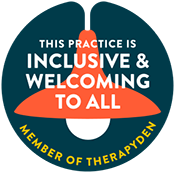What IS Trauma?
When you go through something overwhelming—whether it’s a single painful event or a pattern of difficult experiences over time—your nervous system does what it’s built to do: it steps in to protect you! These automatic responses, like shutting down or staying on high alert, are designed to keep you safe. But when those survival patterns stick around long after the danger has passed, they can start to interfere with your daily life, relationships, and sense of self.
Understanding Trauma and Its Impact
Acute trauma usually comes from a single event—like an accident, assault, or sudden loss—that shocks your system and overwhelms your ability to cope.
Chronic trauma can develop from being in unsafe or unpredictable environments over time, such as ongoing bullying, emotional abuse, or systemic violence. When this happens, your system may stay stuck in survival mode because it needs to keep protecting you, but that also makes it hard to relax, feel safe, or trust your body’s signals.
Complex trauma often starts in childhood and involves repeated disruptions in safety and care—like emotional neglect, abandonment, or abuse. Because these experiences happen in relationships where you were supposed to feel protected, they can shape the way you see yourself, relate to others, and move through the world.
What’s the Difference Between Acute, Chronic, and Complex Trauma?
- Constant anxiety or feeling “on edge”
- Nightmares, flashbacks, or distressing memories
- Feeling emotionally numb or disconnected
- Trouble sleeping or relaxing
- Mood swings or intense emotional reactions
- Avoiding reminders of painful experiences
- A sense of being stuck in self-doubt or shame
- Difficulty trusting others or feeling close
- Physical tension, fatigue, or other body symptoms
How Trauma May Show Up in Your Life:
- Feeling like you’re “too much” or “not enough”
- Struggles with boundaries or trusting relationships
- Difficulty calming down or feeling steady
- Recurring patterns of self-sabotage or burnout
- A deep sense of disconnection or emptiness
- Getting stuck in cycles of people-pleasing or overworking
- Feeling like you don’t fully know who you are
When It Starts Early: Signs of Childhood or Complex Trauma
Many people who’ve experienced trauma are diagnosed with anxiety, depression, panic disorder, or even personality disorders—without ever being asked what happened to them. These labels might describe the symptoms, but they don’t always explain why you feel the way you do.
You may have spent years trying different kinds of treatment, wondering why nothing fully helps. When trauma goes unrecognized, it’s easy to feel stuck or even blame yourself. But naming trauma as the root can be a powerful shift—and the start of real healing.
When the Diagnosis Misses the Root
Healing isn’t just about managing symptoms—it’s about helping your body and mind feel safe again, reconnecting with who you are, and creating a life that feels more steady, empowered, and aligned.
In our work together, we’ll go at your pace. I’ll meet you with warmth, curiosity, and deep respect for everything you’ve been through. Many of the people I work with have tried therapy before or felt like they had to “hold it together” for a long time—without anyone really asking where the pain started. I create space to explore the roots of that pain gently and safely, so you can begin to understand not just what’s happening, but why—and what to do about it.
My Approach to Trauma-Informed Therapy
We’ll begin with simple tools to support your nervous system—things like breathwork, grounding, and mindful noticing. These practices help you feel more calm, more present, and more in control, so your system doesn’t feel like it’s always bracing for impact.
Helping Your System Feel Safe
What Our Work Together Might Include:
We’ll begin with simple tools to support your nervous system—things like breathwork, grounding, and mindful noticing. These practices help you feel more calm, more present, and more in control, so your system doesn’t feel like it’s always bracing for impact.
Understanding What’s Going On Internally
We’ll begin with simple tools to support your nervous system—things like breathwork, grounding, and mindful noticing. These practices help you feel more calm, more present, and more in control, so your system doesn’t feel like it’s always bracing for impact.
Exploring the Past, Gently and Safely
We’ll begin with simple tools to support your nervous system—things like breathwork, grounding, and mindful noticing. These practices help you feel more calm, more present, and more in control, so your system doesn’t feel like it’s always bracing for impact.
Healing in Relationship
Ultimately, my goal as your therapist is to help you reclaim your story, heal from past wounds, and build relationships and a life you genuinely love.
Schedule a consultation Call
Finding the right therapist is an important step, and this consultation is a chance for us to see if we’d be a good fit. In this brief call, we’ll talk about what you’re looking for in therapy, how I may be able to help, and whether my expertise aligns with your needs. This is also an opportunity for a quick “fit check”—therapy works best when you feel comfortable with your therapist, so we’ll get a sense of how we connect before scheduling an intake session. There’s no pressure or obligation—just a chance to explore whether working together feels right for you.
15-Minute Consultation
Free
We’ll talk about what you’re looking for in therapy, how I may be able to help, and whether my expertise aligns with your needs. It's a no pressure "fit check."
